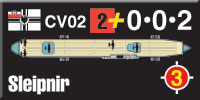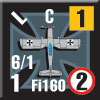The Cruel Sea:
German Carrier Planes
by Mike Bennighof, Ph.D.
July 2019
 In the world of the Second Great War, the fixed-wing airplane is much less advanced than in our own history, thanks in large part to the First World War ending in late 1916 rather than late 1918. Aircraft carriers, by extension, are also less developed in our alternative-history story line. In the world of the Second Great War, the fixed-wing airplane is much less advanced than in our own history, thanks in large part to the First World War ending in late 1916 rather than late 1918. Aircraft carriers, by extension, are also less developed in our alternative-history story line.
They do exist, and though Britain’s Royal Navy holds a substantial lead in carrier technical development and tactics Imperial Germany operates two of them, the old carrier Ausonia now relegated to training duties and the big converted liner Sleipnir which is part of the High Seas Fleet. As my friend Kristin Ann High has pointed out, such a small carrier arm represents a highly inefficient use of resources. All of the same training establishments have to be maintained whether a fleet has one carrier or six, at about the same cost. And investments have to be made in airplanes to fly from the lone carrier, as has happened in Imperial Germany where the Naval Air Service has ordered a small series of specialized aircraft.
 The Second Great War story branches off from actual history with a December 1916 negotiated peace that almost happened (Woodrow Wilson made the offer to mediate, and most of the warring powers wished to accept it). In crafting the story of the decades that followed, I’ve tried to extrapolate from actual events and trends, and in supplying the participants with ships and aircraft, I’ve put an emphasis on ships and aircraft that actually existed or were planned, at least as much as possible. That’s the case with the aircraft of Imperial Germany in 1940, appearing in the Second Great War at Sea: The Cruel Sea expansion set. The Second Great War story branches off from actual history with a December 1916 negotiated peace that almost happened (Woodrow Wilson made the offer to mediate, and most of the warring powers wished to accept it). In crafting the story of the decades that followed, I’ve tried to extrapolate from actual events and trends, and in supplying the participants with ships and aircraft, I’ve put an emphasis on ships and aircraft that actually existed or were planned, at least as much as possible. That’s the case with the aircraft of Imperial Germany in 1940, appearing in the Second Great War at Sea: The Cruel Sea expansion set.
Imperial Germany’s most common fighter plane is the Fokker D.XVII. In our own history, Anthony Fokker built a series of very successful fighters for Germany during the First World War, including the famous Triplane flown by the Red Baron and the highly effective D.VII (a plane so feared, that surrender of all examples was specified in the Treaty of Versailles). In 1919, eager to escape a massive income tax bill and the Versailles ban on building combat aircraft, Fokker moved his operation to the Netherlands and within a decade had become the world’s largest aircraft maker.

Dutch D.XVII fighters.
In our own reality, the D.XVII entered Dutch service in 1932. It showed its origins in the D.VII, but was a much sleeker plane. The biplane set records when new, but by 1939 had been relegated to training duties. A few of them saw limited action during the 1940 German invasion of the Netherlands.
In the world of the Second Great War, Anthony Fokker paid his taxes and never left Germany; given the close economic bonds between Imperial Germany and the Netherlands, the Dutch would have given him up had the Germans pursued the case. Fokker remains a major supplier of aircraft to both the German Naval Air Service and the Luftstreitkräfte.
 The D.XVII is both the Imperial Navy’s standard carrier fighter and the mainstay of its land-based fighter squadrons. It has good range for a fighter of its time (better than most German or British fighters of the early years of the actual Second World War), an armament of two machine guns (pretty standard for the time) and no ability to carry bombs or other ordnance (also pretty standard). In our own history, it was barely considered combat-capable, though probably no worse a fighter than the British or Italian biplanes still in use in 1939. In the world of the Second Great War, it is a deadly fighter and a worthy successor to the D.VII. It’s been exported to Finland, Poland and Ottoman Turkey where it serves exclusively as a land-based fighter. The D.XVII is both the Imperial Navy’s standard carrier fighter and the mainstay of its land-based fighter squadrons. It has good range for a fighter of its time (better than most German or British fighters of the early years of the actual Second World War), an armament of two machine guns (pretty standard for the time) and no ability to carry bombs or other ordnance (also pretty standard). In our own history, it was barely considered combat-capable, though probably no worse a fighter than the British or Italian biplanes still in use in 1939. In the world of the Second Great War, it is a deadly fighter and a worthy successor to the D.VII. It’s been exported to Finland, Poland and Ottoman Turkey where it serves exclusively as a land-based fighter.
Some carrier squadrons operate the DFS.193, an unusual tail-less aircraft designed by Alexander Lippisch (who would design the rocket-powered Messerschmitt Me163 in our own reality). Lippisch tested his plane in a wind-tunnel, but the project would be abandoned afterwards. In our story, the tail-less fighter is seen as ideal for carrier operations thanks to the ease of stowage – a carrier hangar can accommodate almost half again as many of the little fighter as it can accept the bigger D.XVII. Development proceeds and the strange little plane is accepted as a Navy fighter in 1939.

A Russian replica of the DFS.193 (no prototype was actaully built).
The DFS.193 is a nimble, two-seater high-wing monoplane, highly maneuverable in a dogfight. The real DFS.193 carried no armament – it never reached the prototype stage – so ours has the rather standard pair of machine guns firing through the propeller and has no ability to drop bombs or depth charges. Its range is less than the D.XVII; there’s just not much airplane in which to fit fuel tanks.
 With its slight frame and light weight, the DFS.193 makes a better zeppelin-carried fighter than the Arado Ar. 65 that equips the flying carriers, and it is undergoing testing and modifications for this role when our story begins. With its slight frame and light weight, the DFS.193 makes a better zeppelin-carried fighter than the Arado Ar. 65 that equips the flying carriers, and it is undergoing testing and modifications for this role when our story begins.
Note: I drew the DFS.193 (and D.XVII) myself, and am quite proud of them. Getting a note from Susan Robinson, who does our layout, that “there’s something wrong with this drawing” made it worthwhile.
German carriers do not operate a dive bomber; their strike capability comes solely from their torpedo squadrons. In contrast to the carrier fighters, the Fieseler Fi.160 torpedo plane is a fictional aircraft. Fieseler built the Fi.167 torpedo plane for the proposed Nazi aircraft carrier Graf Zeppelin; it was an exceedingly ugly aircraft with outstanding short-takeoff-and-landing qualities.
 Our Fi.160 represents an older model that never actually existed, positing that the design team was forced to work with a less-capable engine and had less-advanced examples from which to borrow ideas. It has shorter range and less combat capability (torpedo planes in Second World War at Sea are rated for their ability to put a torpedo on its target, not for the size of their torpedo). Our Fi.160 represents an older model that never actually existed, positing that the design team was forced to work with a less-capable engine and had less-advanced examples from which to borrow ideas. It has shorter range and less combat capability (torpedo planes in Second World War at Sea are rated for their ability to put a torpedo on its target, not for the size of their torpedo).
The German carrier planes have a monopoly of the skies in The Cruel Sea, as the French and Russians bring no aircraft carriers into the fray. That changes in The King’s Ships, when the Royal Navy shows its advanced carrier development and it’s the Germans forced to somehow catch up.
You can order The Cruel Sea right here, right now.
Sign up for our newsletter right here. Your info will never be sold or transferred; we'll just use it to update you on new games and new offers.
Mike Bennighof is president of Avalanche Press and holds a doctorate in history from Emory University. A Fulbright Scholar and award-winning journalist, he has published over 100 books, games and articles on historical subjects.
He lives in Birmingham, Alabama with his wife, three children and his dog, Leopold.
|
